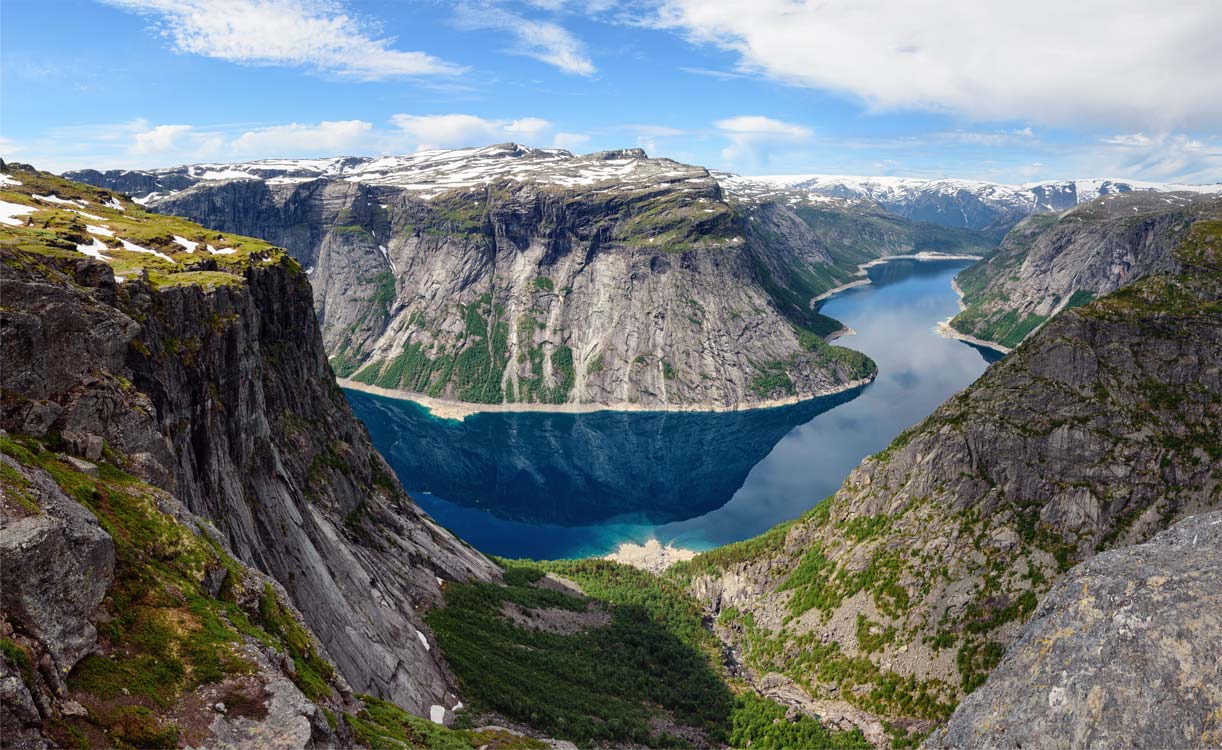Commanding over 13,000 square miles of majestic mountains, meandering fjords, and historic habitations, Vestland is a dreamscape of a county. A land of giants, it features the largest glacier in Europe which feeds Norway’s tallest waterfall. The westernmost point of Norway proper is on a tiny island far out to sea from the mouth of the Norway’s longest fjord, Sognefjorden. It is less than 200 miles east of the Shetland Islands of Scotland.

About 80 miles south of the Sognefjord stands Bergen, Norway’s second-largest city. Founded in 1070, the “City of Seven Mountains” has bustled with international trade and served as a springboard for tourism for a thousand years. In 1350, the Hanseatic League, an international trading conglomerate based in Germany, planted one of its four overseas offices here, specializing in the lucrative stockfish trade. Today, their old wharfs are a UNESCO Heritage Site called Bryggen. Though the neighborhood has been ravaged by fire over the centuries, 62 of the original brightly-painted wooden buildings still stand, reflecting radiantly in the harbor.
There are countless things to do and see in Bergen. There is the haunted Bergenhus Fortress guarding the harbor since the 13th century. You can visit the four KODE art museums in the city center, and tour the restored homes of Edvard Grieg, violinist Ole Bull and 20th century composer Harald Sæverud. You can hike or ride a cable car up the surrounding mountains for a spectacular view of the city and beyond. Countless cruise ships sail in and out of Bergen, many of them set to sail up Vestland’s three most famous fjords.
Stretching 66 miles near the northern border of Vestland, Nordfjorden is the shortest of the three. Small fishing villages, dating back to Viking times, dot its shoreline. If you keep sailing straight where it forks in two, you will land at the village Nordfjordeid, home to the Norwegian Fjordhorse Center. Norway’s small and rugged national horse breed was developed from the Westland Horse in this region. If you trek further east, you will splash into Hornindalsvatnet, the deepest lake in Europe.
Hardangerfjorden cuts up diagonally through the south of the county, and at 111 miles, it is the second-longest fjord in Norway. This region is not only a treasure trove of cascading waterfalls, lush apple orchards, and bountiful mountain farms, but the seat of several famous cultural traditions as well. Hardanger embroidery and the Hardanger fiddle were both developed here, and the regional bunad is one of the most recognizable and colorful in all of Norway. Hardangersfjorden also features countless hiking opportunities, one of which is the perilous climb to Trolltunga. This 7-10-hour hike, recommended only to the most robust travelers, climbs up to the Troll’s Tongue, a long, thin protrusion of rock jutting out 700 meters (2300 feet) above the lake below, and offering stunning views of the surrounding mountains, cliffs and valleys.
Sognefjorden, the longest fjord in Norway at 127 miles, cracks straight through the center of Vestland fylke, like a bolt of many-forked lightning. It is called “the King of Fjords” and adventure awaits at every turn. Here you can board the Flåm Railway, one of the steepest railway lines in the world. You can also find gateways to Jostedalsbreen glacier—Europe’s largest—and Jotunheimen National Park. Urnes stavkirke (stave church) presides on the shoreline, across from the village of Solvorn. It is the oldest church in Norway having been built in 1130. Today, it has been declared a UNESCO Heritage Site.
In 1985, Sissel Kyrkjebø sang of her home county, “Oh Vestland, Vestland, when I see it like this, with beautiful mountains and fjords and narrow coves. It rises up in all its beauty, great and wild and meets me once again so tender and soft.” Resplendent in natural beauty and steeped in culture and heritage, Vestland county is indeed a land of superlatives. It encompasses all that Norway has to offer, wrapped in a dream.
